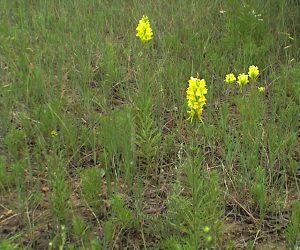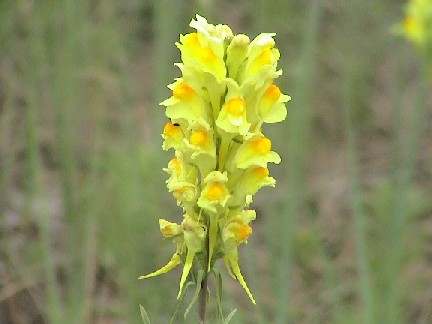Yellow Toadflax (Linaria vulgaris Mill.)
Identification
Yellow toadflax is a perennial with stems that grow from one to three feet tall. The pale green leaves are narrow, linear, and pointed at both ends. Flowers are bright-yellow with an orange center, with a spur that is approximately as long as the rest of the flower combined. Flowers occur in clusters near the ends of the stems, becoming more widely spaced along the stem as the season progresses. Seed capsules are round, and two-celled. Seeds are small, brown or black, circular, and surrounded by a notched wing.
History
Yellow toadflax was introduced to North America as an ornamental plant. It is still sold today in nurseries and seed catalogs as “Butter and Eggs” or “Wild Snapdragon”. Be aware of what species are included in wildflower seed mixes, always look on the back of the product container for a listing of what’s included in the mix. If toadflaxes are listed, PLEASE DO NOT buy that product.
Biology
 Yellow toadflax typically emerges around mid-April. Flowering occurs from May through August, with seeds maturing from July through October. A mature plant can produce up to 30,000 seeds annually a single stem has been reported to contain over 5,000 seeds. Seeds can remain dormant in the soil for up to ten years. Yellow toadflax can reproduce both by seeds and vegetatively. It can aggressively form colonies through adventitious buds from creeping root systems.
Yellow toadflax typically emerges around mid-April. Flowering occurs from May through August, with seeds maturing from July through October. A mature plant can produce up to 30,000 seeds annually a single stem has been reported to contain over 5,000 seeds. Seeds can remain dormant in the soil for up to ten years. Yellow toadflax can reproduce both by seeds and vegetatively. It can aggressively form colonies through adventitious buds from creeping root systems.
Habitat and Distribution
Yellow toadflax can be found in well-drained, coarse-textured soils but can also be found in heavier soils as well. Sites where yellow toadflax can establish include roadsides, riparian areas, dry fields, grainfields, waste areas, gravel pits, pastures and rangeland, vacant lots, and railroad yards. In Adams County, yellow toadflax infestations can be found along the South Platte River, along Clear Creek, and in various lakes and ponds.
Impacts
From seed distribution to creeping root systems, yellow toadflax can aggressively form colonies. These colonies can push out native grasses and other perennials, thereby altering and simplifying the species composition of natural communities and reducing forage production for livestock and wildlife. This in turn reduces rangeland value and can lead to erosion problems.
Management
The key to controlling yellow toadflax is to destroy seedlings that emerge from the soil seed bank, limit vegetative spread of colonies, and maintain a cover of native perennial plants to discourage future infestations.
Prevention
Be sure to check and clean your hiking boots, vehicle/bike tires, pet fur, livestock fur, farm equipment, and construction equipment thoroughly before leaving a toadflax infested area. Seeds can be transported very easily on these items and ready for deposit in an otherwise uninfested area. Watch out for fill dirt and landscaping soils, also another means of dispersal for toadflax seeds into uninfested areas.
Chemical
The optimal time for herbicide application is during the flowering stage, this is when carbohydrate reserves in the root of the plants are at their lowest. Herbicides that have been somewhat effective on yellow toadflax control are picloram (Tordon 22K*), glyphosate (Roundup**), dicamba (Banvel), and chlorsulfuron (Telar DF). Repeat applications are necessary to achieve control.
Mechanical
Hand-pulling yellow toadflax can be effective for small infestations. This should be done before seed-set and repeated as long as there are viable seeds in the soil (up to ten years). Hand-pulling, if repeated for a number of years, may also deplete the nutrient reserves in the root system. Mowing will reduce the year’s growth and reduce the amount of seed set, but is not an effective option for long-term control. Cultivation is effective in controlling yellow toadflax if performed for two years 8 to 10 times the first year, 4 to 5 times the second.
Bio-Controls
One species, Calophasia lunula is effective if used in an integrated weed management program. The C. lunula larvae feed extensively on the leaves and flowers of toadflax, severely damaging the plant. C. lunula is available through the Colorado Department of Agriculture’s Division of Plant Industry’s Biological Pest Control Section. You may contact the insectary by dialing (970) 464-7916.




